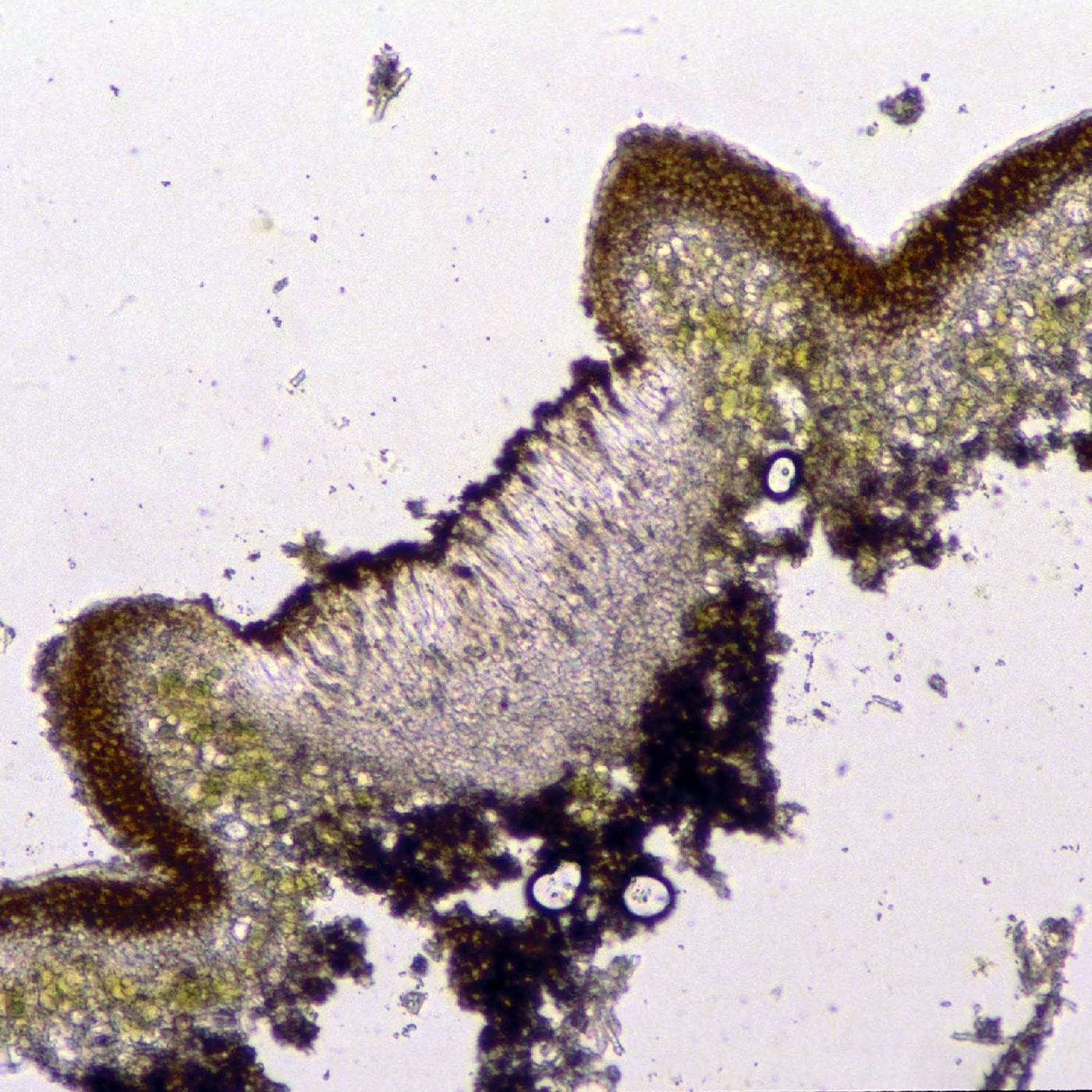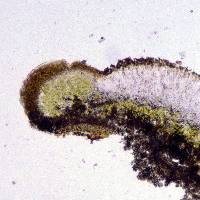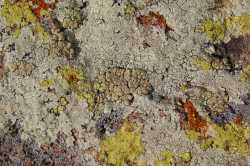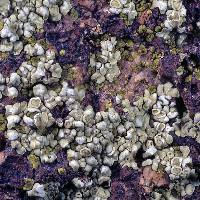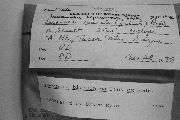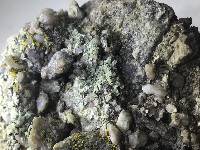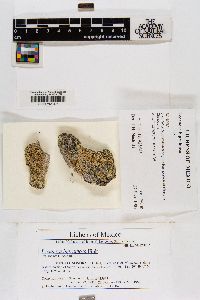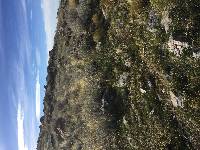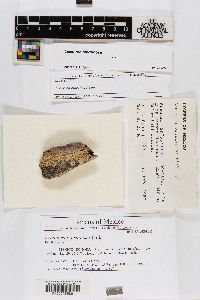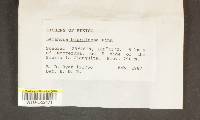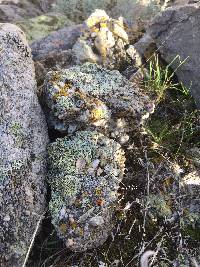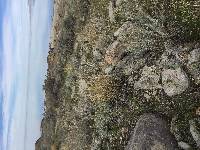
Consortium of Lichen Herbaria
- building a Global Consortium of Bryophytes and Lichens as keystones of cryptobiotic communities -
- Home
- Search
- Images
- Species Checklists
- US States: O-Z >
- US National Parks
- Central America
- South America
- US National Parks
- Southern Subpolar Region
|
|
|
|
Family: Lecanoraceae
[Lecanora bipruinosa Fink] |
Nash, T.H., Ryan, B.D., Gries, C., Bungartz, F., (eds.) 2004. Lichen Flora of the Greater Sonoran Desert Region. Vol 2. Thallus: placodioid, up to 3 cm wide, 1-2 mm thick, thinning towards margins, rosetted, closely to somewhat loosely attached, rimose-areolate to verrucose-areolate or subsquamulose; prothallus: absent areoles: 0.7-1.5(-2) mm, roundish to somewhat crenate or partly angular, plane to +convex lobes: distinct, contiguous to discrete, usually elongated, (1.5-)2-3(-4) mm long, 0.5-1.5 mm wide, 0.3-0.5 mm thick, thinner towards tips, plane to convex, transversely +broken-furrowed, weakly incised to branched, the ultimate segments c. 0.5 mm wide; edges: appressed, entire to irregularly and coarsely undulate-crenate and +raised or thickened (as in L. muralis) upper surface: mainly smooth and continuous, to shallowly rimulose, often slightly bumpy or foveolate near tips of lobes, dull to (especially towards lobe tips and on darkened edges) +distinctly glossy, usually spotted with fine white pruina, usually pale yellowish green to moderate or grayish greenish yellow, slowly turning pale yellow or finally pale brown, areas near tips and edges often blue-green; edges: concolorous with the rest or often paler, but usually not pruinose; extreme lobe tips: sometimes narrowly blackened, without thallospores, esorediate upper cortex: without dead algal cells, 50-70 µm thick; hyphae: +anticlinal, thin-walled, 3-4 µm wide, the lumina 3-5 x 2-3 µm; epinecral layer: 10-30 µm thick medulla: dense, to rather loose in lower part; hyphae: randomly oriented; algal layer: +continuous lower surface: pale brownish, often mottled greenish or bluish black lower cortex: absent Apothecia: borne submarginally, 1-3(-5) per areole, 0.5-2 mm in diam., scattered to crowded, soon sessile and constricted disc: yellowish brown (to pale orange or green) under +dense yellow pruina, otherwise appearing pale greenish yellow to pale green, gray, or brown, unchanged when wet. plane or slightly convex margin: 0.1-0.2(-0.3) mm wide, entire to flexuous, or cracked-crenate from outside, raised then level, partly almost disappearing, flat-topped to rather convex; concolorous with thallus, spottily pruinose in outer part, without a parathecial ring amphithecium: present, with a continuous to somewhat interrupted algal layer densely filling apothecial margin and extending below the hypothecium, with a rather loose medulla containing fine granules soluble in K, corticate; cortex: similar to that of thallus, 30-50 µm thick parathecium: up to 30 µm thick laterally and up to 70 µm thick below hypothecium, with hyphae partly or completely oriented periclinally to the hymenium, the lumina +round to short and irregular and c. 5 x 2-3 µm epihymenium: with layer of superficial yellow-brown granules (soluble in K) hymenium: 50-65 µm tall; paraphyses: coherent; tips: 2.5-3 µm wide, scarcely colored; subhymenium: hyaline, 30-50 µm thick; hypothecium: 75-100 µm; hyphae: randomly oriented to partly vertically oriented, strongly conglutinate, the lumina often unstained, +elongated, 3-5 x 0.1-0.2 µm asci: broadly clavate, 8-spored ascospores: hyaline, simple, ellipsoid to narrowly ellipsoid, ovoid or fusiform, 10-12(-14) x (4-)5-6(-7.5) µm Pycnidia: usually common, immersed; ostioles pale; conidiophores: type III of Vobis (1980) conidia: mostly 25-35 µm long Spot tests: thallus K-, C-; cortex KC+ yellow, P-; medulla KC-, P+ yellow or P- Secondary metabolites: cortex with usnic acid; medulla with psoromic acid or fatty acids (murolic acid complex, with neodihydromurolic acid major). Substrate and ecology: on volcanic tuff, basalt, rhyolite, or sedimentary rocks, often with a thin coating of calcareous dust, frequently on shaded, north-facing surfaces, from desert scrub to woodlands World distribution: SW U.S.A. and NW Mexico, south through the Sierra Madre Occidental to central Mexico Sonoran distribution: Arizona, California, Baja California, Chihuahua and Sonora, (200-)610-1040 m. Notes: Lecanora bipruinosa differs from L. novomexicana by having: 1) shorter, straighter and flatter (not sinuous or plicate) lobes, often with partly thickened edges, + pruinose upper surface; 2) upper cortex with few or no dead algal cells, hyphae densely packed, partly forming anticlinal bundles, with larger, shorter and rounded lumina; 3) apothecial margins often 0.3 mm or more wide and rather flat-topped; and 4) occurrence in desert areas, mostly below 100 m and 30'N. Material from Arizona often has rather short and broad lobes with thickened margins (resembling those of L. nashii; see under that species for further comparisons). Occasional psoromic acid-deficient specimens from Sonora have very narrow lobes with a +epruinose, dark bluish-green upper surface. Thalli and discs are often parasitized by with small black ascocarps, 0.05-0.1 mm in diam., of Stigmidium sp. and Cercidospora spp. (determined by J. Hafellner). |
|
|
|
Powered by Symbiota

